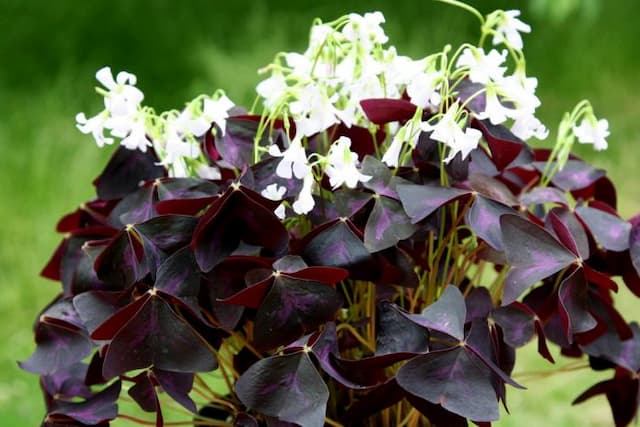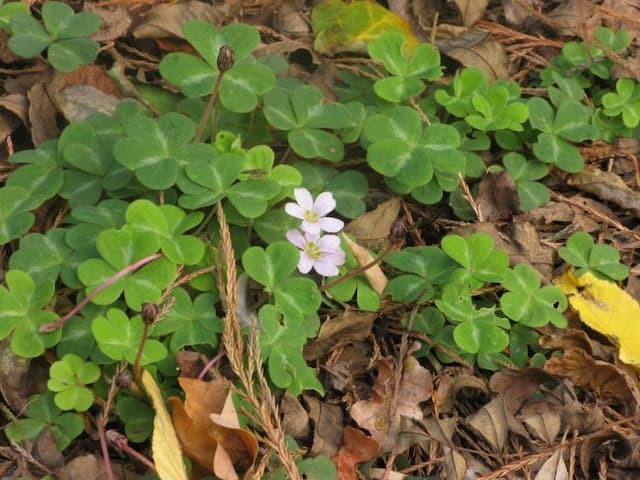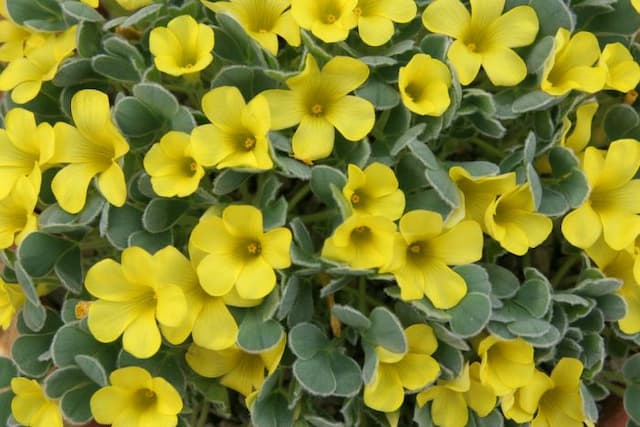Scurvy Grass Sorrel Oxalis enneaphylla

ABOUT
Commonly known as the Scurvy grass sorrel, this plant is known for its attractive foliage and delicate flowers. It has a clump-forming habit and showcases tufts of clover-like leaves that are usually green but may have shades of purple or burgundy, especially in cooler temperatures. Each leaf is made up of three heart-shaped leaflets that are joined together at the base, giving them a distinct, ornamental appearance. The Scurvy grass sorrel blooms with eye-catching flowers during its flowering season, each consisting of five white to light pink petals that are often adorned with contrasting lines or marks that act as guides for pollinating insects. These blossoms are symmetrical and open up to reveal a bright yellow center composed of numerous stamens. The entire plant gives off a delicate and charming impression, being both aesthetically pleasing and intriguing in its structure. The combination of its trifoliate leaves and striking blossoms makes it a favorite among garden enthusiasts and plant collectors alike.
About this plant
 Names
NamesFamily
Oxalidaceae.
Synonyms
Scurvy Grass, Silver Shamrock, Nine-leaved Pink Sorrel, Patagonian Oxalis.
Common names
Oxalis enneaphylla var. minima, Oxalis hatcheri, Acetosella enneaphylla, Ionoxalis enneaphylla, Xanthoxalis enneaphylla.
 Toxicity
ToxicityTo humans
The plant commonly known as Scurvy Grass, Oxalis enneaphylla, contains oxalic acid, which can be toxic when consumed in significant quantities. Oxalic acid can bind with calcium in the body to form calcium oxalate crystals, potentially leading to kidney stones and other health issues. While the occasional small amount is not typically harmful, consuming larger amounts of the plant can result in symptoms such as nausea, vomiting, diarrhea, abdominal pain, and in severe cases, kidney damage. Hence, it's advisable to avoid ingesting this plant, particularly in large quantities.
To pets
Scurvy Grass, Oxalis enneaphylla, is toxic to pets due to its content of oxalic acid. When pets ingest parts of the plant, the oxalic acid can cause symptoms similar to those in humans, including vomiting, diarrhea, and lethargy. If consumed in large enough amounts, it can lead to more serious issues like kidney failure, particularly in animals with pre-existing kidney problems or in small pets due to their lower body weight. It is especially important to prevent pets from eating this plant to avoid potential health complications.
 Characteristics
CharacteristicsLife cycle
Perennials
Foliage type
Evergreen
Color of leaves
Green
Flower color
Pink
Height
0.16 feet (5 cm)
Spread
0.66 feet (20 cm)
Plant type
Bulb
Hardiness zones
7
Native area
Patagonia
Benefits
 General Benefits
General Benefits- Aesthetic Appeal: Oxalis enneaphylla, commonly known as Scurvy Grass, adds visual interest to gardens with its delicate pink or white flowers and clover-like foliage.
- Low Maintenance: It is relatively easy to care for, requiring minimal attention once established in the right conditions.
- Cold Tolerance: Scurvy Grass is hardy in cold climates, making it a good choice for gardens in cooler regions.
- Ground Coverage: Its growth habit helps to cover bare spots in the garden and can suppress weeds through its spreading nature.
- Drought Resistance: Once established, it can tolerate periods of drought, making it suitable for xeriscaping or low-water gardens.
- Pollinator Attraction: The flowers can attract pollinators such as bees and butterflies, benefiting the garden ecosystem.
 Medical Properties
Medical PropertiesThis plant is not used for medical purposes.
 Air-purifying Qualities
Air-purifying QualitiesThis plant is not specifically known for air purifying qualities.
 Other Uses
Other Uses- Oxalis enneaphylla, commonly known as Scurvy-grass sorrel, can be used as a natural dye, providing a range of colors when the leaves are processed.
- In some cultures, Scurvy-grass sorrel's leaves are added to salads for a tangy, lemon-like flavor due to its high vitamin C content.
- The plant can be grown as a groundcover in rock gardens, offering an aesthetic and easy-to-maintain landscaping option.
- Scurvy-grass sorrel, when planted, can serve as an indicator of soil pH, with its growth vigor reflecting soil conditions.
- The plant may be utilized in educational settings to demonstrate the clover-lookalike trifoliate leaf structure and how it differs biologically from true clovers.
- With its decorative blooms, Scurvy-grass sorrel can be used to create natural, sustainable flower arrangements that provide a rustic touch to homes or events.
- Its resilient nature allows it to be used in erosion control on slopes or banks where other plants might not thrive.
- Culinary enthusiasts might use the tart leaves of the Scurvy-grass sorrel as a natural souring agent in cooking, similar to how one would use lemon zest.
- Children can be taught about the process of photosynthesis and plant biology through observing the plant's growth and response to light conditions.
- The hardy characteristics of Scurvy-grass sorrel make it an excellent choice for bonsai cultivation, especially for beginners seeking to practice with less delicate species.
Interesting Facts
 Feng Shui
Feng ShuiThe Oxalis is not used in Feng Shui practice.
 Zodiac Sign Compitability
Zodiac Sign CompitabilityThe Oxalis is not used in astrology practice.
 Plant Symbolism
Plant Symbolism- Luck: Oxalis, commonly known as wood sorrel, is often associated with good fortune because of its resemblance to the lucky four-leaf clover.
- Joy: The delicate and cheerful appearance of the wood sorrel flowers symbolizes joy and happiness in many cultures.
- Resilience: Wood sorrel can thrive in a range of conditions, making it emblematic of resilience and adaptability.
 Water
WaterThe Scurvy-grass Sorrel should be watered sparingly, as it is susceptible to root rot if overwatered. Typically, it should be watered once every week or two, allowing the soil to dry out slightly between waterings. When you do water, aim to give the plant about 4 ounces of water, ensuring it reaches the root zone without flooding the pot. During its dormant phase in summer when the foliage dies back, reduce watering significantly, offering just enough to keep the soil from completely drying out.
 Light
LightScurvy-grass Sorrel thrives best in bright, indirect light conditions. It prefers a spot that receives several hours of morning sun with dappled light or partial shade in the afternoon. Avoid placing it under the harsh direct sun of midday, which can scorch its delicate leaves, and also keep it away from deep shade, where it won't get enough light to grow properly.
 Temperature
TemperatureThe ideal temperature conditions for Scurvy-grass Sorrel range from 60 to 75 degrees Fahrenheit. It can tolerate a minimum temperature down to about 50 degrees Fahrenheit but should not be exposed to freezing conditions. Make sure to protect the plant from drastic temperature changes and keep it away from drafts and heating vents.
 Pruning
PruningPruning Scurvy-grass Sorrel is essential to remove spent flowers and encourage a compact growth habit. This should be done after the flowering season, typically in late spring or early summer, to tidy up the plant. Cut back any dead or yellowing leaves, as this will help prevent disease and encourage new, healthy growth.
 Cleaning
CleaningAs needed
 Soil
SoilScurvy-grass sorrel thrives in a well-draining, sandy soil mix with some organic matter. Aim for a slightly acidic to neutral pH range, between 5.5 to 7.0 for optimal growth.
 Repotting
RepottingScurvy-grass sorrel should be repotted every 2 to 3 years to refresh the soil and accommodate its growing tubers.
 Humidity & Misting
Humidity & MistingScurvy-grass sorrel prefers moderate humidity levels but is quite adaptable and can tolerate the typical humidity found in most homes.
 Suitable locations
Suitable locationsIndoor
Place Scurvy-grass sorrel in bright, indirect light and keep soil moist.
Outdoor
Grow Scurvy-grass sorrel in partial shade and protect from hot sun.
Hardiness zone
4-9 USDA
 Life cycle
Life cycleOxalis enneaphylla, commonly known as the Scurvy-grass Sorrel, starts its life cycle as a seed, which requires a moist, cool environment to germinate. Upon germination, the seedling emerges and develops into a small rosette of clover-like foliage, drawing nutrients from the soil and beginning photosynthesis. As it matures, the plant develops its signature umbrella-shaped leaves and starts to establish a bulb-like structure underground, which allows it to survive adverse conditions. The Scurvy-grass Sorrel will then produce delicate pink to white flowers, typically during the spring and early summer, which are pollinated by insects, leading to the formation of seed capsules. Seeds are dispersed by several mechanisms, including wind and water, and upon finding a suitable environment, they will remain dormant until the next growing season. The plant demonstrates a perennial growth habit, where the above-ground parts may die back in unfavorable seasonal conditions, while the bulbs persist and regenerate the following season.
 Propogation
PropogationPropogation time
Spring-Early Summer
The Oxalis enneaphylla, commonly known as the Scurvy Grass Sorrel, is typically propagated through division, a popular method that can be performed during its dormant period, often in late summer to early autumn. To propagate by division, carefully lift the clump of bulbs from the ground using a garden fork, ensuring you don't damage the bulbs. Gently tease apart the individual bulbs, which should come apart with little resistance. Each bulb can then be replanted in well-draining soil, spaced about 4 inches (approximately 10 centimeters) apart, and at a depth roughly twice the height of the bulb. Water the newly planted bulbs gently to settle the soil around them, and with time, these will grow into new Scurvy Grass Sorrel plants. This method leverages the natural reproductive cycle of the plant and is a straightforward way to expand your collection or share with fellow gardeners.




